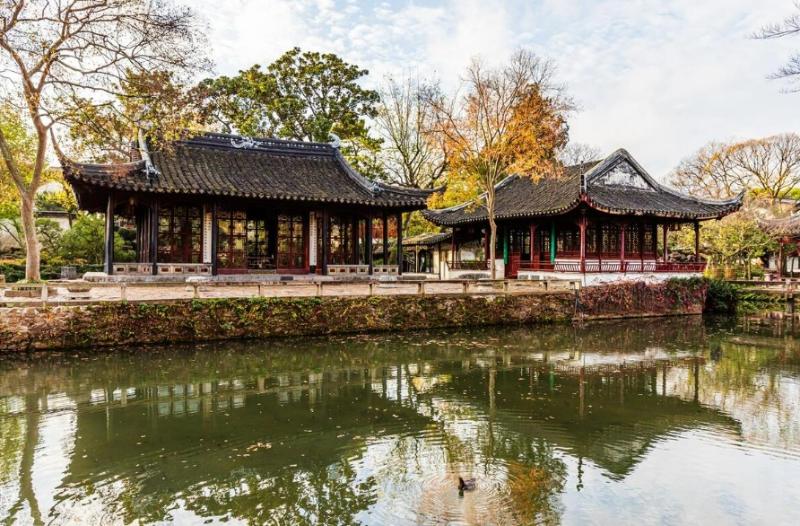Humble Administrator’s Garden

The Humble Administrator's Garden: A Masterpiece of Chinese Classical Gardens
The Humble Administrator's Garden, located in Suzhou, Jiangsu Province, China, is a private garden built by Wang Xianchen during the late Ming Dynasty. It was inscribed as a UNESCO World Heritage Site in 1997. Renowned for its ingenious blend of natural and artificial landscaping, and meticulous architectural layout, it stands as an outstanding representative of Chinese classical gardens, earning the title of “the crown jewel of Jiangnan gardens.”
I. A Perfect Fusion of Nature and Artificiality
The design philosophy of the Humble Administrator's Garden emphasizes “learning from nature,” seamlessly integrating the garden into Suzhou’s natural environment, creating a sense of “though made by man, it seems to be natural.”
-
The Ingenious Use of Water Features: The Humble Administrator's Garden centers around water, dividing the garden into east, middle, and west sections. The eastern part prioritizes water, with vast expanses of water surface adorned with rock formations and pavilions, evoking a magnificent scene of shimmering waves and sky merging with water. The middle section utilizes water as an axis, connecting various attractions with meandering waterways, creating a captivating landscape of shimmering water and bustling boats. The west section uses water as a backdrop, using rock formations and flora to craft an atmosphere of tranquility and seclusion, showcasing a “winding path leading to a secluded spot, a Zen temple hidden among flowers and trees” ambiance.
-
The Ingenious Use of Rock Formations: The rock formations in the Humble Administrator's Garden primarily consist of Taihu stones, each unique in shape and posture, complementing the water features, forming a vibrant tapestry of mountains and rivers. The eastern rock formations stand tall and majestic, symbolizing rugged mountains, while the middle formations prioritize elegance, reflecting the graceful spirit of the Jiangnan water town. The western formations emphasize tranquility, creating a sense of “mountains and rivers seem to end, but another village appears at the end of a willow-lined path.”
-
The Ingenious Use of Plants: The Humble Administrator's Garden uses plants to create scenes, incorporating seasonal changes into the garden, crafting diverse landscapes. In spring, the garden explodes with flowers, brimming with life. Summer brings leafy shade, blocking the sun, offering respite and rejuvenation. Autumn paints the garden in fiery hues of red leaves, while winter presents a unique charm with bare branches braving the snow.
II. Meticulously Crafted Architectural Layout
The architectural layout of the Humble Administrator's Garden is sophisticated, with pavilions, towers, corridors, bridges, and water pavilions taking center stage, embodying the essence of Chinese classical architecture.
-
Key Structures: The Humble Administrator's Garden features key structures like the Distant Fragrance Hall, the Pavilion of All-Around Lotus Fragrance, the Listening Pavilion, the Fragrant Islet, and the Thirty-Six Pairs of Ducks Pavilion. These buildings embody the classic Jiangnan architectural style, prioritizing simplicity, elegance, and tranquility, harmonizing seamlessly with the garden's environment.
-
Layout Features: The architectural layout of the Humble Administrator's Garden emphasizes “shifting views with every step,” each structure offering unique functions and characteristics, echoing the surrounding environment. For instance, the Distant Fragrance Hall, situated at the garden's heart, served as the host's reception area and venue for banquets, its architectural style grand and elegant, reflecting the host's status and position. The Pavilion of All-Around Lotus Fragrance sits by the water, a spot for appreciating lotuses and relaxation, its architectural style serene and graceful, offering peace and tranquility.
-
Meticulous Craftsmanship: The details of the architectural structures within the Humble Administrator's Garden are exquisite, for example, the glazed tiles on the roofs, the carvings on the window frames, and the murals on the walls, all showcasing the exquisite craftsmanship of ancient Chinese artisans.
III. Cultural Connotations and Historical Legacy
The Humble Administrator's Garden is not just a masterpiece of architectural art but also a museum encapsulating ancient Chinese culture and thought.
-
Cultural Connotations: The Humble Administrator's Garden embodies the “unity of heaven and man” philosophy in traditional Chinese culture, as well as the aesthetic appreciation of “those who love benevolence find joy in mountains, while those who love wisdom find joy in water.” It ingeniously merges nature and humanity, crafting a peaceful, harmonious, and transcendent ambiance, allowing visitors to experience the profound depth of ancient Chinese culture.
-
Historical Legacy: The Humble Administrator's Garden has endured hundreds of years of historical changes while preserving its original character, becoming a model for Chinese classical gardens. It not only bears witness to the evolution of ancient Chinese society but also carries the essence of ancient Chinese culture, leaving behind a precious cultural heritage for future generations.
The Humble Administrator's Garden, as a representative of Chinese classical gardens, stands as a UNESCO World Heritage Site due to its perfect fusion of nature and artificiality, meticulously crafted architectural layout, and profound cultural connotations, serving as a window for people to understand ancient Chinese culture and art.